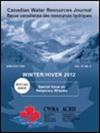Performance of automated geoprocessing methods for culvert detection in remote Forest environments
IF 1.7
4区 环境科学与生态学
Q3 WATER RESOURCES
引用次数: 1
Abstract
Abstract Greater availability of digital elevation models (DEMs) derived from airborne light detection and ranging (LiDAR) has made it possible to map precisely hydrographic features such as streams over large watersheds. Road embankments are precisely detected, given that DEMs are especially accurate over open areas, while culverts are not. Consequently, mapped stream positions are often erroneous along and through these anthropogenic structures. The position of actual culverts is often imprecise, incomplete or unavailable for large territories; thus, there is a need to develop and evaluate automated methods to locate culvert positions by remote sensing. Six geoprocessing methods were tested and compared to field-based culvert positioning data gathered in forested areas. These methods rely on preprocessing of depressions, manipulation of road embankment elevation, or both. When exact locations of culverts were unknown, the ‘Breach Depressions’ algorithm (WhiteBox GAT) was most accurate in reducing omission and commission errors. Depending upon the expected stream flow regime, it was possible to reduce cumulative error from 10% to 30% by using this method compared to less effective methods. When exact locations of culverts were known, it was possible to reduce cumulative error from 20% to 45% by burning them into the DEM. Comparisons of two different methods revealed that no automated geoprocessing allowed accurate detection of poorly located culverts, i.e. where small streams deviated into road-side ditches. Despite automated geoprocessing methods that are available, a database geolocating all culverts within a territory is the best way to create exact hydrographic networks without road embankment influence.用于偏远森林环境中涵洞检测的自动地理处理方法的性能
摘要基于机载光探测和测距(LiDAR)的数字高程模型(DEM)的可用性越来越高,这使得精确绘制大流域河流等水文特征成为可能。路堤被精确地检测到,因为DEM在开阔区域尤其准确,而涵洞则不然。因此,沿着这些人为结构和通过这些人为结构绘制的河流位置往往是错误的。实际涵洞的位置往往不精确、不完整或不适用于大片地区;因此,有必要开发和评估通过遥感定位涵洞位置的自动化方法。测试了六种地质处理方法,并将其与在森林地区收集的基于现场的涵洞定位数据进行了比较。这些方法依赖于凹陷的预处理、路堤高程的操纵,或两者兼而有之。当涵洞的确切位置未知时,“Breach Depression”算法(WhiteBox GAT)在减少遗漏和调试错误方面最准确。根据预期的水流状况,与效果较差的方法相比,使用该方法可以将累积误差从10%降低到30%。当涵洞的确切位置已知时,可以通过将其刻录到DEM中,将累积误差从20%降低到45%。对两种不同方法的比较表明,没有自动地质处理能够准确检测位置不佳的涵洞,即小溪流入路边沟渠的地方。尽管有可用的自动地理处理方法,但在不受路堤影响的情况下,对一个地区内的所有涵洞进行地理定位的数据库是创建精确水文网络的最佳方式。
本文章由计算机程序翻译,如有差异,请以英文原文为准。
求助全文
约1分钟内获得全文
求助全文
来源期刊

Canadian Water Resources Journal
WATER RESOURCES-
CiteScore
2.90
自引率
5.90%
发文量
17
审稿时长
>12 weeks
期刊介绍:
The Canadian Water Resources Journal accepts manuscripts in English or French and publishes abstracts in both official languages. Preference is given to manuscripts focusing on science and policy aspects of Canadian water management. Specifically, manuscripts should stimulate public awareness and understanding of Canada''s water resources, encourage recognition of the high priority of water as a resource, and provide new or increased knowledge on some aspect of Canada''s water.
The Canadian Water Resources Journal was first published in the fall of 1976 and it has grown in stature to be recognized as a quality and important publication in the water resources field.
 求助内容:
求助内容: 应助结果提醒方式:
应助结果提醒方式:


